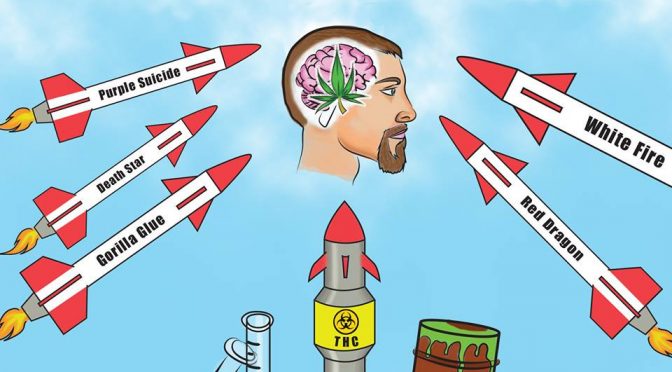An opinion from Colorado
By Robin Noble
It was prom night 2018, but my teenager wouldn’t be putting on a tuxedo. He had been throwing up since dawn.
His low back was aching, a sign of kidney distress. He needed to go to the ER. It would be our 11th trip in just over nine months. I found myself hesitating because, at about $8,000 a visit, even with insurance the costs were severe.
My son was suffering from cannabinoid hyperemesis syndrome (CHS). Once rare, the condition is being seen increasingly in Colorado and other states that have legalized marijuana. It includes intractable vomiting and, strangely, compulsive hot water bathing.
By the time most patients accept that the problem is caused by pot, they have been to the ER multiple times, tried anti-nausea drugs, anti-anxiety medications, antidepressants, and endured tests like upper endoscopies and colonoscopies.
My son did not believe pot could make him sick. He read articles hyping it as a medical miracle while his body screamed for mercy.
Our prom-night drive to the ER was pure misery, with my son retching and begging me to hurry. A white limousine pulled next to us, windows down and party music bumping. I recognized two boys inside who had played sports with my son. They were radiant, and the contrast hit hard.
All roads lead to marijuana
When I reflect on nights like that and everything our teenager endured and lost, I find all roads lead to marijuana.
Entering high school, my son was a joyful athlete, but school, sports, and friendships were quickly eclipsed by an addiction to high-potency pot. When we finally understood what was happening, there was no easy way back.
Recovery has been challenging and expensive, but we are in a better place today. We know other families whose kids have fared worse, some with serious psychiatric impacts they will deal with for life.
As a parent, I feel undermined by the easy access kids have to ultra-potent pot, and the unhealthy messages that bombard our youth. Legalization alone was a powerful influence. The branding of marijuana as medicine fostered a false sense of safety.
Commercial marijuana has spurred a potency arms race that has produced products bearing no resemblance to the relatively mild pot most of us thought we were legalizing.
In the ‘90s, marijuana had an average of 4% THC, the ingredient that creates a high. In Colorado, a 2020 study found 93% of products were more than 15% THC with stores advertising products up to 95% THC, according to a state report. The rise of CHS and other health problems mirrors the rise in THC.
Colorado data and the state of science
Recently Colorado’s Department of Public Health and Environment released data showing a significant increase in teen use of highly-potent products like nearly pure THC resin, also known as wax and shatter, which is “dabbed” using a blowtorch. More than half of Colorado high school students who use marijuana said they dab.
When young people with developing brains use high-concentrate THC products, it can seriously and irreparably harm their intellect, mental health, and physical well being. This is settled science.
Despite tight controls inside pot businesses, Colorado kids can get any product sold in a dispensary. Industry and law enforcement know, but can’t seem to do anything about, 18-year olds with easily obtained medical cards reselling high-potency products to younger friends. Laws prohibiting multiple-dispensary purchases are not enforced, and “shoulder-tapping” (teens asking an adult to buy on their behalf) is common.
I’m a liberal Democrat. I oppose jailing people for marijuana. But Colorado’s experience demonstrates the consequences to kids of unchecked commercialization.
The marijuana industry has yet to acknowledge the role of high-THC marijuana in CHS, psychosis, depression, and suicide in teenagers. Unlike Big Tobacco, the marijuana industry has not yet been forced to face up to the harm its products can cause.
Once Chance to Grow Up
This is why I’ve joined other families in telling our stories to parents and policymakers through the One Chance to Grow Up initiative (onechancetogrowup.org). We don’t campaign against legalization, but we do advocate safeguards for kids.
It’s time for Colorado legislators to address regulatory gaps that endanger our youth. The case for thoughtful caps on THC potency is clear and compelling. Also, Colorado must start treating medical marijuana more like a medicine, and close loopholes that allow 18- to 20-year-olds to create a pipeline of high-THC products into schools.
As a pioneer in legal marijuana, Colorado can model putting kids before profits, or become a cautionary tale in allowing a reckless industry to run amuck.
This opinion was first published in the Colorado Sun, January 12, 2021. Robin Noble is a member of Boulder’s Cannabis Licensing and Advisory Board. Here are more testimonies from Colorado: Johnny Stack’s Story I wish we had never moved here My son’s psychiatric surprise
This article explains more about Cannabinoid Hyperemesis Syndrome. Here is another testimony about the illness.

